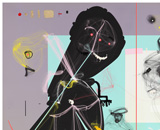April 16, 2010

Colour, as pop artist Roy Lichenstein once pointed out, is crucial in painting, but very hard to talk about. With infinite shades and tones, juxtapositions and overlaps, it's little wonder that artists from Monet to Van Gogh have called it their joy and torment. In this latest exhibition at Chatterjee & Lal, it is colour that comes to the forefront, and dominates over the content, creating a kaleidoscopic explosion of a group show.
Delhi-based artist Aditya Pande's mad scribbles are paired alongside the fable-like paintings of Swiss couple Michael Husmann and Pascale Mira Tschaeni, and save for two or three works of muted black and white, you're apt to feel you're somewhere between Care Bear land and My Little Pony world. Fittingly, the Tschaenis have made their kids, Zama and Nalo, the centrepieces of most of their works, imbibing them with a child-like cheeriness that makes them impossible to not like.
Pande is a graphic designer turned artist who uses a vector based software to create his paintings, which are really graphics of sorts. Layering them with blocks of intense colour (magenta, bronze, fuschia, saffron organge), and spidery thin grids, Pande first prints them out using a pigment ink printer. He then works on them by hand, employing everything from push pins and silicon glue to pieces of rock (taken from the road outside his house) and insects that unwittingly get stuck in his thick blobs of impasto paint. There are discernible forms, like the helicopter and bird, that act as anchors in these dizzying landscapes drawn from the bottomless wells of nature and the Internet (look out for a real wasp exoskeleton and Wikipedia images of bacteria). But they almost seem beside the point.
While it may be easy to dismiss them as the fanciful scribblings of someone practicing on a programme like Windows' Paint for instance, Pande's dexterity with the software is undeniable. A diptych of two figures, one of the dancing girl and another of the bust of the priest-king from Mohenjo Daro, are nimbly executed using his needle thin line technique. Yet Pande is careful to avoid making a facsimilie, disrupting their rudimentary likeness with geometric stacks.
The Tschaenis are also art magpies, collecting in their works all manner of patterns, prints, and designs. Working on polyster film, the couple paints in collaboration, slowly building up layers on the reverse of the plate. What we see is from the other side through a smooth layer of glass. Michael draws the children, furniture, animals and other realistic renderings; Mira handles the more organic elements, the patterns, and prints, and drawings of cells. Sometimes the children are allowed to add their own doodles, and peering up close, it's possible to spy stick figures and random blobs drawn in pencil. But it's the children, immersed under these layers of texture, that provide the most fun. They may be trapped, literally and figuratively, but which child wouldn't want to live in a world of rainbows, teddy bears, cupcakes and peacock feathers? While not exactly Wonderland, it's a world not too far off from it.
Go Back